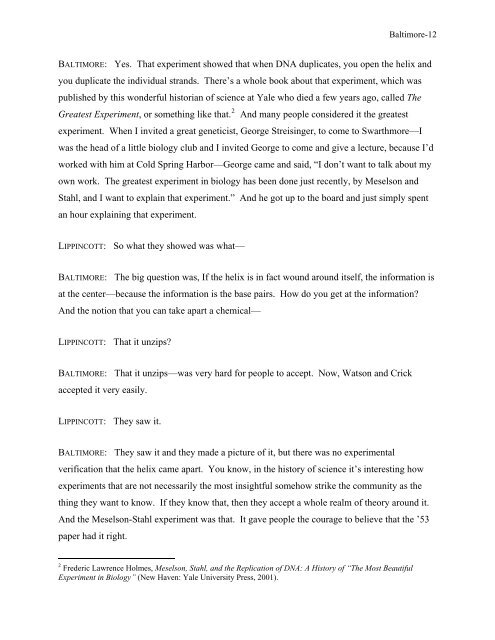Interview with David Baltimore - Caltech Oral Histories
Interview with David Baltimore - Caltech Oral Histories
Interview with David Baltimore - Caltech Oral Histories
You also want an ePaper? Increase the reach of your titles
YUMPU automatically turns print PDFs into web optimized ePapers that Google loves.
<strong>Baltimore</strong>-12<br />
BALTIMORE: Yes. That experiment showed that when DNA duplicates, you open the helix and<br />
you duplicate the individual strands. There’s a whole book about that experiment, which was<br />
published by this wonderful historian of science at Yale who died a few years ago, called The<br />
Greatest Experiment, or something like that. 2 And many people considered it the greatest<br />
experiment. When I invited a great geneticist, George Streisinger, to come to Swarthmore—I<br />
was the head of a little biology club and I invited George to come and give a lecture, because I’d<br />
worked <strong>with</strong> him at Cold Spring Harbor—George came and said, “I don’t want to talk about my<br />
own work. The greatest experiment in biology has been done just recently, by Meselson and<br />
Stahl, and I want to explain that experiment.” And he got up to the board and just simply spent<br />
an hour explaining that experiment.<br />
LIPPINCOTT: So what they showed was what—<br />
BALTIMORE: The big question was, If the helix is in fact wound around itself, the information is<br />
at the center—because the information is the base pairs. How do you get at the information<br />
And the notion that you can take apart a chemical—<br />
LIPPINCOTT: That it unzips<br />
BALTIMORE: That it unzips—was very hard for people to accept. Now, Watson and Crick<br />
accepted it very easily.<br />
LIPPINCOTT: They saw it.<br />
BALTIMORE: They saw it and they made a picture of it, but there was no experimental<br />
verification that the helix came apart. You know, in the history of science it’s interesting how<br />
experiments that are not necessarily the most insightful somehow strike the community as the<br />
thing they want to know. If they know that, then they accept a whole realm of theory around it.<br />
And the Meselson-Stahl experiment was that. It gave people the courage to believe that the ’53<br />
paper had it right.<br />
2 Frederic Lawrence Holmes, Meselson, Stahl, and the Replication of DNA: A History of “The Most Beautiful<br />
Experiment in Biology” (New Haven: Yale University Press, 2001).

















